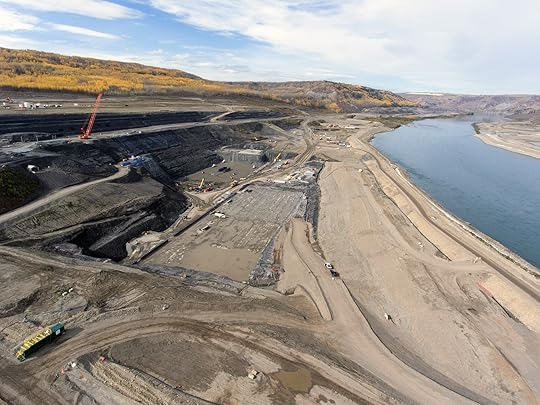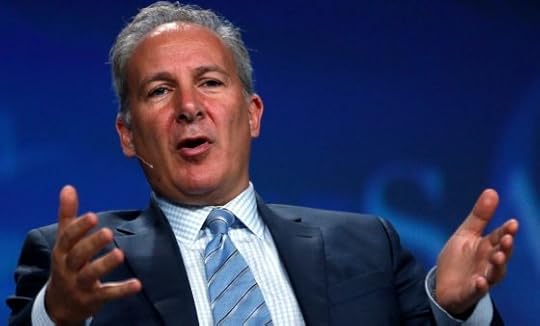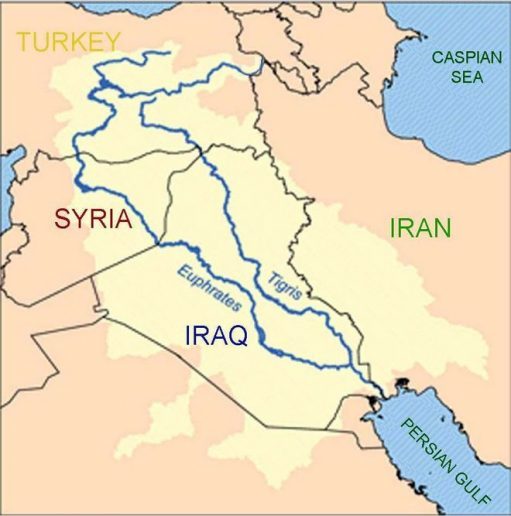Steve Bull's Blog, page 1204
February 1, 2018
Megadams Not Clean or Green, Says Expert
Forty years of research show hydro dams create environmental damage, says David Schindler.
 ‘When you add the emissions from building and producing materials for a dam, as well as the emissions from clearing forests and moving earth, the greenhouse gas production from hydro is expected to be about the same as from burning natural gas,’ says professor David Schindler. Photo from BC Hydro.
‘When you add the emissions from building and producing materials for a dam, as well as the emissions from clearing forests and moving earth, the greenhouse gas production from hydro is expected to be about the same as from burning natural gas,’ says professor David Schindler. Photo from BC Hydro.Politicians who describe dams as “clean energy projects” are talking “nonsense” and rejecting decades of science, says David Schindler, a leading water ecologist.
Former premier Christy Clark often touted the Site C dam as a “clean energy project” and Premier John Horgan has adopted the same term.
But that’s not the story told by science, Schindler told The Tyee in a wide-ranging interview.
In fact studies done by federal scientists identified dams as technological giants with lasting ecological footprints almost 40 years ago, he said.
Dam construction and the resulting flooding produces significant volumes of greenhouse gas emissions. Canadian dams have strangled river systems, flooded forests, blocked fish movement, increased methylmercury pollution, unsettled entire communities and repeatedly violated treaty rights.
Schindler, a professor emeritus at the University of Alberta and an internationally honoured expert on lakes and rivers, pointed to the increased mercury levels as a health and environmental risk. “All reservoirs that have been studied have had mercury in fish increase several-fold after a river is dammed,” he said.
“How can any of those impacts be regarded as green or clean?”
The Site C dam is no exception. A report by the University of British Columbia’s Program on Water Governance found the Site C project, which faced a federal-provincial Joint Review Panel in 2014, “has more significant negative environmental effects than any other project ever reviewed under the Canadian Environmental Assessment Act (including oilsands projects).”
…click on the above link to read the rest of the article…
Stepping Back from the Brink
An astonishing new field of enquiry explores the deep changes that could avert a planetary disaster
We know where we’re going. For many years, scientists have warned that we are crashing through the Earth’s ecological limits. We know we are in the midst of climate breakdown and ecological collapse. Yet we seem constitutionally incapable of acting on this knowledge.
The United States has elected a man who promised to unleash a gigantic ecological tantrum, and has, unfortunately, delivered. The UK government has produced 150 pages of greenwash it calls the 25 Year Environment Plan: the same gutless twaddle governments have been publishing for the past 25 years. As always, it was described in some quarters as “a good start”. No policy, anywhere, is commensurate with the scale of the challenge we face.
So what stops us from responding? For years, I’ve suspected that the cause runs even deeper than the power of big business and the official obsession with economic growth, potent as these forces are. Now, thanks to the most profound and far-reaching book I have ever read, I feel I’m beginning to understand what it might be.
Jeremy Lent’s The Patterning Instinct was published a few months ago, but it has taken me this long to process, as almost every page caused me to rethink what I held to be true. Bringing together cultural history with neuroscience, Lent develops a new discipline he calls cognitive history.
From infancy, our minds are shaped by the culture we grow into, which lays trails we learn to follow, like paths through a field of tall grass. Helping us to construct these patterns of meaning are powerful root metaphors embedded in our language. Without our conscious knowledge, they guide the choices we make.
…click on the above link to read the rest of the article…
The Rowboat (Wages) and the Yacht (Assets)
As I keep saying: the status quo has divested the working and middle classes.
The reason why the status quo has failed and is fragmenting is displayed in these three charts of wages, employment and assets: wage earners (labor) are in a rowboat trying to catch the yacht of those who own assets (capital).
Here is a chart of weekly wages of those employed fulltime: up a gargantuan $4/week in the 18 years since 2000. Let’s see, $4 times 52 week a year–by golly, that’s a whole $208 a year. Brand new Ford F-150, here we come!
If we go back 38 years to 1980–an entire lifetime of work–we find real (adjusted for official inflation, which seriously understates big-ticket expenses such as rent, healthcare and college tuition/fees) wages have notched higher by $10/week–a gain of $500 annually.
If we adjusted wages by real-world income, we’d find wages have declined since 1980 and 2000.

Here’s employment by age group since the year 2000. THose who can’t afford to retire are still dragging their tired old bones to work while employment for the under-55 cohort hasn’t even returned to the levels of 2000.

Meanwhile, asset valuations have soared. Those who own capital (assets) have done very, very well, those who trade their labor for dollars–they’ve gone nowhere.

Households with two regular jobs could afford to buy a house in Seattle, Brooklyn, or the San Francisco Bay Area in 1995. By 2005, they were priced out. Can a household with median income ($59,000 annually) afford a crumbling shack in any of the white-hot housing markets? You’re joking, right?
The cold reality is wage-earners are tugging on the oars of a water-logged rowboat, trying to catch up with the sleek yacht of asset owners. The system has been rigged to reward those who own assets (capital) or who can borrow immense sums of nearly-free money (credit) to buy assets.
…click on the above link to read the rest of the article…
Resisting Tyranny: Struggling for Seed Sovereignty in Latin America
The Latin America Seeds Collective has just released a 40-minute film (‘Seeds: Common or Corporate Property?) which documents the resistance of peasant farmers to the corporate takeover of their agriculture.
The film describes how seed has been central to agriculture for 10,000 years. Farmers have been saving, exchanging and developing seeds for millennia. Seeds have been handed down from generation to generation. Peasant farmers have been the custodians of seeds, knowledge and land.
This is how it was until the 20th century when corporations took these seeds, hybridised them, genetically modified them, patented them and fashioned them to serve the needs of industrial agriculture with its monocultures and chemical inputs.
To serve the interests of these corporations by marginalising indigenous agriculture, a number of treaties and agreement over breeders’ rights and intellectual property have been enacted to prevent peasant farmers from freely improving, sharing or replanting their traditional seeds. Since this began, thousands of seed varieties have been lost and corporate seeds have increasingly dominated agriculture.
The Food and Agriculture Organization of the United Nations estimates that globally just 20 cultivated plant species account for 90 percent of all the plant-based food consumed by humans. This narrow genetic base of the global food system has put food security at serious risk.
To move farmers away from using native seeds and to get them to plant corporate seeds, the film describes how seed ‘certification’ rules and laws are brought into being by national governments on behalf of commercial seed giants like Monsanto. In Costa Rica, the battle to overturn restrictions on seeds was lost with the signing of a free trade agreement with the US, although this flouted the country’s seed biodiversity laws.
…click on the above link to read the rest of the article…
A Brief (and Messy) History of Modern Gold Standards
Although gold prices hit a new high in mid-January, Americans, by and large, are still reluctant about gold. They don’t quite “get it.” This incomprehension is different than that of Americans not “getting,” for example, bitcoin (as few seem to). They may understand gold as a safe haven that has always stood the test of time, war, crises, inflation, etc. Some also understand that no gold proponent advocates harkening back to a mythical 19th century gold hey-day (one that did not exist — certainly not consistently), or recommends re-issuing gold minted currency, or reverting to any kind of bimetallism (the 19th century norm).
That said, the “barbarous relic” view tends to persist. Overall, it is thought that gold simply has no place in a modernized (read: central bank-controlled) economy. Making matters more complex is the question of what is gold and what is not. The recent proliferation of gold derivatives, “paper gold,” ETFs, certificates, bogus gold; the Chinese, the Russians, depleted reserves, actual supply make its study opaque and abstract. In light of this confusion, a basic overview of the role of gold in an economy, both in classic and modern terms, is in order:
The Complexity of the Age of Gold Standards
In the beginning of the modern economic era of the later 19th century, a pure “gold standard” was never consistent. However, its rise to preeminence as ‘the’ pillar of sound economic theory was that of gold’s role as a hedge against inflation and against Unsound Money — paper money easily manipulated to reckless credit whims. In this regard, the European central banks of the day were excellent watchdogs.
…click on the above link to read the rest of the article…
January 31, 2018
Peter Schiff: ‘The Price Of Gold Is Going To Soar’ And ‘The Dollar WILL Collapse’

Peter Schiff recently attended the Vancouver Resource Investment Conference. While he was there, he did an interview with Daniela Cambone of Kitco News and Schiff said gold is going to soar.
But Schiff (who predicted the 2008 recession) also explains why he believes now may be a good opportunity to invest in physical gold. Schiff said that the standard sentiment shared by many is that once the Federal Reserve jacks up interest rates, gold will stay level and unaffected. But that didn’t happen. Schiff said that the yellow metal has surprised the initial expectations that it would fall when the Fed raised rates; gold has climbed 9% since the Fed hiked last month.
Gold has not really rallied. It’s been going up, right? But it’s been creeping higher. Now, everybody expected it to fall. Everybody believed that as soon as the Fed hiked rates, gold’s gonna tank. And it didn’t tank. It rallied. -Peter Schiff
Investors tend to sell the rumor of rate hikes and buy the fact when in reality, the higher interest rates are not bearish for gold. But as Peter points out, that mindset still exists in the market.
But you know, the Fed keeps raising rates a little bit, every once in a while, and everybody still believes that, well, the Fed is raising rates, so that’s bearish for gold. So, everybody expects gold to fall, yet it continues to creep higher. But I think once it overcomes some of this resistance – it has a lot of resistance around $1,350 – and I think if we can decisively move above that and then get above $1,400, just to make sure it’s cleared out, then I think it’s off to the races.
…click on the above link to read the rest of the article…
Greenspan Warns: “We Have A Stock Market Bubble”
US equity markets stumbled notably as former Fed Chair Alan Greenspan told Bloomberg TV that “we have a stock market bubble.”

Greenspan stuck to his usual discussion topics of low productivity and fiscal doomsday inevitability…
“Productivity has been dead in the water for the past 10 years…
I’ve never believed in the Phillips Curve…
Adding that “we’ve got to confront the budget deficit,” concluding “we’re dealing with a fiscally unstable long-term outlook.”
Something we have heard before (in 2016) when Greenspan warned
“Entitlements are crowding out savings, and hence capital investment. Capital investment is the critical issue in productivity growth, and productivity growth in turn is the crucial issue in economic growth. We’re running to a state of disaster unless we turn this around.“
“This should be the central issue of the presidential debate. Unless and until we can rein in entitlements, which have been rising at a nine percent annual rate in the United States and comparable levels throughout the world, we are going to find that productivity is going to maintain a very low rate of increase”
Greenspan also doesn’t really view recession as the biggest problem right now, he is concerned (rightfully so) about the longer term problem of low economic growth and soaring entitlement growth.
“I don’t think that’s our problem. Our problem is not recession which is a short-term economic problem, I think youhave a very profound long-term problem of economic growth at the time when in the Western world there is a very large migration from being a worker to being a recipient of social benefits“
But when Greenspan said the following…
“There are two bubbles. We have a stock market bubble and a bond market bubble. At the end of the day, the bond bubble will be the big issue.“
Stocks began to stumble…

…click on the above link to read the rest of the article…
How regional rivalries threaten to fuel the fire in Syria and Iran
 Credit: Wikimedia
Credit: Wikimedia Turkish allegations of Saudi, Emirati and Egyptian support for the outlawed Kurdish Workers Party (PKK) threaten to turn Turkey’s military offensive against Syrian Kurds aligned with the PKK into a regional imbroglio.
The threat is magnified by Iranian assertions that low-intensity warfare is heating up in areas of the Islamic republic populated by ethnic minorities, including the Kurds in the northwest and the Baloch on the border with Pakistan.
Taken together, the two developments raise the spectre of a potentially debilitating escalation of the rivalry between Saudi Arabia and Iran as well as an aggravation of the eight-month-old Gulf crisis that has pitted Saudi Arabia and its allies against Qatar, which has forged close ties to Turkey.
The United Arab Emirates and Egypt rather than Saudi Arabia have taken the lead in criticizing Turkey’s incursion into Syria designed to remove US-backed Kurds from the countries’ border and create a 30-kilometer deep buffer zone.
UAE Minister of State for Foreign Affairs Anwar Gargash said the incursion by a non-Arab state signalled that Arab states would be marginalized if they failed to develop a national security strategy.
Egypt, for its part, condemned the incursion as a “fresh violation of Syrian sovereignty” that was intended to “undermine the existing efforts for political solutions and counter-terrorism efforts in Syria,”
Despite Saudi silence, Yeni Safak, a newspaper closely aligned with President Recep Tayyip Erdogan’s ruling Justice and Development Party (AKP), charged that a $1 billion Saudi contribution to the reconstruction of Raqqa, the now Syrian Kurdish-controlled former capital of the Islamic State, was evidence of the kingdom’s involvement in what it termed a “dirty game.”
…click on the above link to read the rest of the article…
UK’s Secret Cold War Plan For Middle East Oil Fields

The 1950s were a turbulent time on both sides of the Iron Curtain. With the Second World War over and the star role played by crude oil in its outcome, British and U.S. intelligence agencies wasted no time working out scenarios should the Soviets invade the Middle East.
In hindsight, especially to younger generations, this might seem eccentric, but not to those who remember the Cold War and the paranoia that raged on both sides. In the 50s, the British and U.S. intelligence services were genuinely concerned about a further Soviet expansion, into the Middle East, which at the time was the main source of crude oil for both countries. No wonder the region was a priority security issue for both countries.
The plans were first hatched by U.S. President Truman in 1949, Russian Sputnik writes, citing a number of recently declassified documents from both the UK and the United States. Dubbed “oil denial”, the plans involved oil company personnel in the Middle East sabotaging their own oilfields and refineries in case of a Soviet invasion, in hopes of restricting the invaders’ access to the precious commodity.
While sound in themselves, the denial plans of the Brits faced problems: the empire’s influence in the Middle East was in decline. Iran’s and Iraq’s governments, according to declassified documents, were believed to be particularly unlikely to cooperate with oil companies in sabotaging their own oil industry.
The reason for this was that the UK no longer had a monopolistic presence in these two, despite the U.S.-led 1953 coup in Iran, which returned the shah to power and BP to the helm of the Iranian oil industry. BP was at the helm, true, but the Iranian government controlled the refineries, and was building more. The Soviet invasion scenario involved not just oilfields but also refineries.
…click on the above link to read the rest of the article…
US National Debt Will Jump by $617 Billion in 5 Months
Just as the Fed accelerates its QE Unwind. Treasuries reacted.
While everyone is trying to figure out how to twist the new tax cut to their advantage and save some money, the US Treasury Department just announced how much net new debt it will have to sell to the public through the second quarter to keep the government afloat: $617 billion.
That’s what the Treasury Department estimates will be the total amount added to publicly traded Treasury securities — or “net privately-held marketable borrowing” — through the end of the second quarter. This will be the net increase in the US debt through the end of Q2. By quarter:
During Q1, the Treasury expects to increase US public debt by $441 billion. It includes estimates for “lower net cash flows.”
During Q2 – peak tax seasons when revenues pour into the Treasury – it expects to increase US public debt by $176 billion.
It also “assumes” that with these increases in the debt, it will have a cash balance at the end of June of $360 billion.
So over the next five months, if all goes according to plan, the US gross national debt of $24.5 trillion currently – which includes $14.8 trillion in publicly traded Treasury securities and $5.7 trillion in internally held debt – will surge to about $25.1 trillion.
That’s a 4% jump in just five months. Note the technical jargon-laced description for this (marked in green on the chart):

The flat lines in 2013, 2015, and 2017 are a result of the prior three debt-ceiling fights. Each was followed by an enormous spike when the debt ceiling was lifted or suspended, and when the “extraordinary measures” with which the Treasury keeps the government afloat were reversed. And note the current debt ceiling, the flat line that started in mid-December.
…click on the above link to read the rest of the article…



